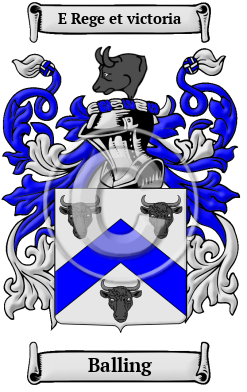| ![Show Contents]() Balling History, Family Crest & Coats of Arms Balling History, Family Crest & Coats of Arms
Etymology of BallingWhat does the name Balling mean? Balling is a name of ancient Norman origin. It arrived in England with the Norman Conquest of 1066. The Balling family lived in Lincolnshire and various other areas throughout Britain. The name of this family, however, does not refer to these areas, but to the French Channel port of "Boulogne." Early Origins of the Balling familyThe surname Balling was first found in various counties throughout Britain. The earliest listing of the name appears to be Gilebert de Bollon who was listed in Northumberland in 1168. 1 Over one hundred years later, the Hundredorum Rolls of 1273 listed: Pharamund de Boloynne in Buckinghamshire; Richard de Boloyne in Somerset; John de Boloyne in Cambridge; and Thomas Boloyne in Essex. 2 Interestingly, the rolls also listed Simon, Count of 'Buloyne' as residing in Oxford. In the reference "History of Norfolk," Simon de Boleyn was listed about the same time. 3 Anne Boleyn (c. 1501-1536), Queen of England from 1533 to 1536 as the second wife of King Henry VIII, claimed descendancy from Geoffrey Boleyn (d. 1440), a yeoman of Salle, Norfolk. Early History of the Balling familyThis web page shows only a small excerpt of our Balling research. Another 94 words (7 lines of text) covering the years 1406, 1440, 1451, 1454, 1463, 1477, 1480, 1499, 1501, 1504, 1505, 1507, 1533, 1536, 1538, 1539, 1543, 1550, 1554, 1569, 1576, 1603, 1632 and 1640 are included under the topic Early Balling History in all our PDF Extended History products and printed products wherever possible. Balling Spelling VariationsIt is only in the last few hundred years that the English language has been standardized. For that reason, Anglo-Norman surnames like Balling are characterized by many spelling variations. Scribes and monks in the Middle Ages spelled names they sounded, so it is common to find several variations that refer to a single person. As the English language changed and incorporated elements of other European languages such as Norman French and Latin, even literate people regularly changed the spelling of their names. The variations of the name Balling include Bullen, Bulen, Bullan, Bulloyne, Bouleyne, Bulleyn and many more. Early Notables of the Balling familySir Geoffrey Boleyn (1406-1463), Lord Mayor of London, son of Geoffrey Boleyn (d. 1440) yeoman of Salle, Norfolk; Sir William Boleyn (1451-1505), the son of Sir Geoffrey Boleyn, a wealthy mercer and Lord Mayor of London; Admiral Sir Charles Bullen; Anne Boleyn (c.1501 or 1507-1536), Queen of England (1533-1536), 1st Marquess of Pembroke, second wife of King Henry VIII; Elizabeth Boleyn (1480-1538), Countess of Wiltshire, mother of Anne Boleyn; George Boleyn (1504-1536), Viscount Rochford, brother of Anne, executed with her for incest, adultery and treason; Mary Boleyn (c.1499-1543), Anne's sister and a long-term mistress of Henry VIII's, who is rumored to...
Another 205 words (15 lines of text) are included under the topic Early Balling Notables in all our PDF Extended History products and printed products wherever possible. Balling Rankingthe United States, the name Balling is the 18,347th most popular surname with an estimated 2,487 people with that name. 4 Migration of the Balling family to IrelandSome of the Balling family moved to Ireland, but this topic is not covered in this excerpt.
Another 80 words (6 lines of text) about their life in Ireland is included in all our PDF Extended History products and printed products wherever possible. Migration of the Balling familyFaced with the chaos present in England at that time, many English families looked towards the open frontiers of the New World with its opportunities to escape oppression and starvation. People migrated to North America, as well as Australia and Ireland in droves, paying exorbitant rates for passages in cramped, unsafe ships. Many of the settlers did not make the long passage alive, but those who did see the shores of North America were welcomed with great opportunity. Many of the families that came from England went on to make essential contributions to the emerging nations of Canada and the United States. Some of the first immigrants to cross the Atlantic and come to North America carried the name Balling, or a variant listed above: Silvester Bullen who settled in Virginia in 1624; John Bullen settled in Maryland in 1775. Richard Bullen arrived in New York State in 1752.
| Contemporary Notables of the name Balling (post 1700) | + |
- Stith Balling, American Republican politician, Delegate to Republican National Convention from Virginia, 1896 5
The motto was originally a war cry or slogan. Mottoes first began to be shown with arms in the 14th and 15th centuries, but were not in general use until the 17th century. Thus the oldest coats of arms generally do not include a motto. Mottoes seldom form part of the grant of arms: Under most heraldic authorities, a motto is an optional component of the coat of arms, and can be added to or changed at will; many families have chosen not to display a motto.
Motto: E Rege et victoria
Motto Translation: The King and victory.
- Reaney, P.H and R.M. Wilson, A Dictionary of English Surnames. London: Routledge, 1991. Print. (ISBN 0-415-05737-X)
- Bardsley, C.W, A Dictionary of English and Welsh Surnames: With Special American Instances. Wiltshire: Heraldry Today, 1901. Print. (ISBN 0-900455-44-6)
- Rye, Walter, A History of Norfolk. London: Elliot Stock, 62, Paternoster Row, 1885. Print
- "What are the 5,000 Most Common Last Names in the U.S.?". NameCensus.com, https://namecensus.com/last-names/
- The Political Graveyard: Alphabetical Name Index. (Retrieved 2016, January 14) . Retrieved from http://politicalgraveyard.com/alpha/index.html
 |

